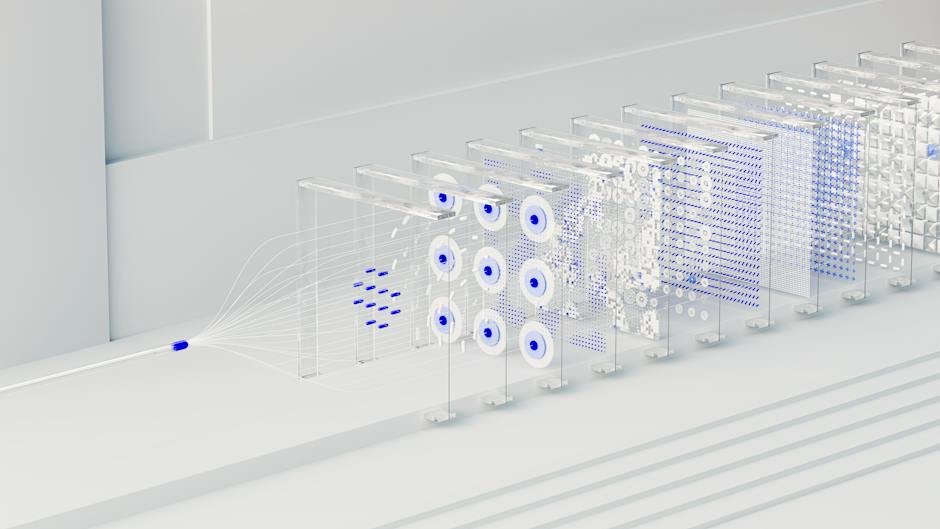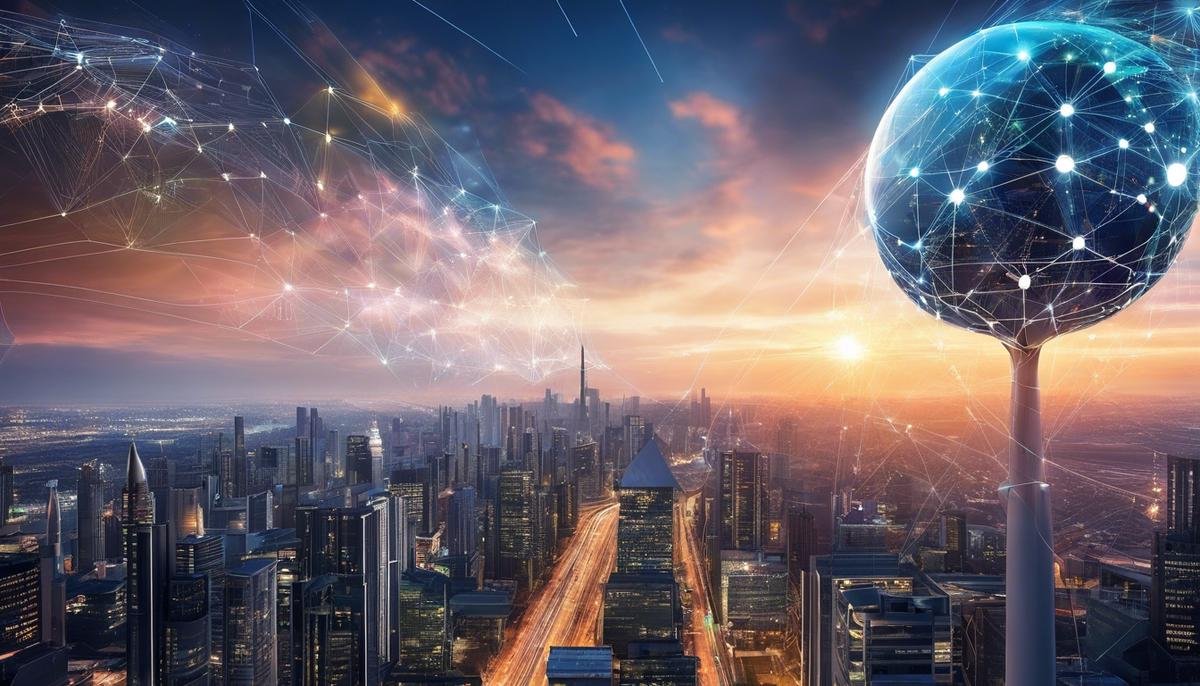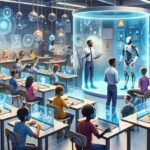As the dawn of a new era in technology steadily approaches, generative artificial intelligence stands at the forefront of a transformative movement set to reshape our interactions with the digital world. This essay embarks on a journey through the landscapes of imagination, ethics, integration, personalization, and collaboration within the realm of AI. We are on the brink of witnessing generative AI evolve beyond mere machine learning to a state of enhanced creativity and quality, rivaling human ingenuity. As we delve deeper into this exploration, we prepare to uncover the future of AI algorithms – sophisticated and nuanced in their ability to produce content that not only inspires but also challenges the status quo across various fields of human endeavor.
Enhanced Creativity and Quality
The Evolution of Creative Capacities in Generative Artificial Intelligence
Generative artificial intelligence (AI) represents a class of technologies capable of producing content, from text and images to music and beyond, by learning from a vast array of existing examples. This burgeoning field is predicated on the notion that machines, when programmed correctly, not only replicate but also innovate, forming new patterns of creativity hitherto unseen within the confines of human endeavor.
As this technology progresses, we are witnessing an evolutionary trajectory that promises to redefine the boundaries of AI-generated creativity. Underpinning this evolution is the meticulous enhancement of machine learning algorithms, specifically those employed in deep learning networks such as Generative Adversarial Networks (GANs) and Variational Autoencoders (VAEs). Through these mechanisms, AI systems “learn” from large datasets, gradually improving their output by emulating the distribution of the input data.
One quintessential progression in this area is the advent of improving contextual understanding. As AI systems assimilate vast troves of contextual information, they begin to recognize and apply nuances of cultural significance, emotional resonance, and symbolic meaning in their creations. The systems of the future will likely exhibit an enhanced capacity to discern subtleties in human communication, allowing them to generate works that resonate more deeply with their human counterparts.
Another foreseeable development is the diversification of AI’s creative output. While current systems often specialize in one form of media, ambitious strides are being made towards creating polymath AI entities capable of cross-domain creativity. These algorithms could seamlessly integrate concepts across various artistic mediums, synthesizing music with visual arts, literature with architecture, thereby blurring the lines between previously distinct artistic disciplines.
Furthermore, as AI systems enhance their interactive capabilities, they may evolve to become not only creators but also collaborators. The prospect of AI serving as a co-creator with humans suggests a paradigm shift where technology amplifies human creativity, pushing it to new frontiers by providing tools that can extend the imaginative process and offer novel perspectives.
Additionally, the ethical dimension of generative AI’s evolution cannot be overstated. The future development of AI’s creative capabilities must be accompanied by rigorous discourse on copyright, authorship, and the potential impact on human creators. These considerations will shape the integration of generative AI in creative industries and broader society.
Ultimately, the trajectory of generative AI’s creative potentials is toward a more nuanced, diverse, and collaborative future. As these technologies refine their ability to interpret and generate human-like creative works, they will not only serve as a testament to human ingenuity but also stand as independent bearers of creativity, potentially transcending the limitations of the human mind and unlocking a new paradigm in the intersection between art and technology.

Ethical and Governance Frameworks
Emerging Ethical Challenges in the Development of Generative AI
As generative artificial intelligence continues to advance, the emphasis on ethical considerations is intensifying. It is becoming increasingly crucial to address the potential impact of AI-generated content on societal norms, privacy, and individual rights. This discussion does not merely speculate on future implications but rather examines concrete ethical challenges that must shape the trajectory of generative AI development.
Generative AI operates within a complex web of societal expectations and legal frameworks. Every new development brings with it a myriad of ethical considerations that are of paramount importance. Without due ethical diligence, the proliferation of AI could lead to unintended consequences that may disrupt social, economic, and cultural systems.
One critical ethical aspect is the balance between innovation and respect for intellectual property (IP). Generative AI can synthesize new content by drawing upon extensive databases of existing works. However, respecting IP rights is imperative to ensure that creators are acknowledged and compensated for their contributions. Navigating the fine line between inspiration and infringement will require robust policies that facilitate AI innovation while safeguarding the interests of human creators.
Privacy is another significant concern, notably when generative AI involves personal data. There is a need for stringent data governance measures to prevent the misuse of private information. The AI’s capacity to process and incorporate such data must be regulated to protect individual privacy and to prevent identity theft, unauthorized surveillance, or other malicious activities. In developing such systems, a commitment to user consent and data security is essential.
Bias is an inherent risk in AI systems, stemming from the datasets on which they are trained. Generative AI must be designed with mechanisms to identify and mitigate biases that could perpetuate stereotypes or discrimination. This requires an ongoing effort to ensure that datasets are diverse and representative of different populations and viewpoints.
Transparency in AI-driven processes is a cornerstone of building trust between technology and society. The ‘black box’ nature of certain AI algorithms can obscure their decision-making processes, leading to skepticism and fear. For generative AI to gain public acceptance, there must be a level of openness in how these systems operate, including disclosure of the AI’s capabilities and limitations, along with the human oversight involved in its deployment.
The autonomy of generative AI systems presents a formidable ethical challenge, particularly as these systems become more self-sufficient. Establishing accountability for AI-generated content and actions is essential. There is a degree of urgency to create legal and ethical frameworks to clarify who or what is responsible when AI systems have significant autonomy. A consensus on accountability will support the responsible elaboration of AI technologies.
Last ly, there is the potential inequality brought about by generative AI. As with any technology, there is a risk of widening the gap between those with access to cutting-edge tools and those without. Ensuring equitable access to the benefits of generative AI is essential to prevent exacerbating economic and social disparities.
Conclusively, while the progressive capabilities of generative AI herald a new era of innovation, they also introduce a spectrum of ethical considerations that require immediate attention. As this domain evolves, there is a collective responsibility to guide its development responsibly, prioritizing ethical imperatives to shape a constructive and inclusive future. The responsible evolution of generative AI is not just a technological imperative but a societal one, with profound implications for the fabric of human culture and interaction.

Interdisciplinary Integration
In recent times, generative AI has commanded attention across various sectors beyond the arts and technology, heralding a transformative potential akin to the advent of the internet. Going forward, this innovative technology is poised to infiltrate new terrains, reshaping industries and spawning uncharted applications.
In the educational sphere, generative AI stands to revolutionize pedagogy through the creation of personalized learning content. By analyzing individual learning styles and progress, AI could tailor educational materials that cater to the specific needs and paces of learners. Furthermore, it may foster interactive and immersive experiences through simulation and virtual environments, offering learners a hands-on approach to complex subjects.
Healthcare also presents fertile ground for the integration of generative AI. The synthesis of novel biochemical compounds and the crafting of patient-specific treatment plans demonstrate the promise of AI to underpin bespoke medical interventions. Moreover, generative models could anticipate disease outbreaks or progressions by analyzing vast amounts of historical and real-time data, offering an invaluable tool for preventive medicine and public health.
Within the realm of urban planning and architecture, generative AI is set to become an indispensable asset. By assimilating multifaceted data such as population growth, environmental concerns, and infrastructural constraints, AI can produce optimized urban layouts and architectural designs that reconcile functionality with sustainability. This could lead to more resilient and adaptable urban spaces that are better equipped to face the challenges of the future.
In the agricultural sector, generative models could engender crop and livestock management plans by simulating environmental changes and market demands. This capability could substantially augment agricultural productivity and resilience while minimizing resource waste and environmental impact. Through precision farming, AI could identify the ideal planting configurations and hybrid plant varieties, thereby securing food supply chains against the destabilizing forces of climate change and population growth.
Lastly, the entertainment and gaming industries are expected to welcome the dawn of hyper-realistic content and dynamic storytelling, with generative AI facilitating procedurally generated narratives and environments that adapt in real-time to user interactions. This has the potential to yield an inexhaustible labyrinth of storylines and settings, presenting users with an unparalleled degree of autonomy within their entertainment experiences.
These domains represent but a mere fraction of the horizons where generative AI could assert a profound influence. The key to the successful implementation of these applications lies in the symbiotic relationship between human oversight and AI’s advanced computational capabilities. Progress in these areas hinges on the thoughtful deployment of generative AI while vigilantly upholding ethical standards and regulatory frameworks designed to safeguard the collective interest. As we venture forward, our goal must be to harmonize the advancement of AI with the enrichment of human society, attuning to the subtle chords that bind technological progress to the human experience.

Personalization and Adaptability
Generative artificial intelligence, an ever-evolving technological marvel, holds the promise to revolutionize the adaptive capabilities of digital systems, thus conforming to individual needs with a sophistication hitherto unseen.
As we delve deeper into the mechanisms by which AI may serve as bespoke solutions for unique user requirements, it is paramount to address the fusion of adaptability and personalization that will characterize the next wave of generative AI systems.
Understanding and catering to individual preferences is a cornerstone of contemporary AI research. Future generative AI systems are anticipated to leverage a multidimensional data influx, capturing nuances of individual behavior, interests, and learning styles. Through intricate analysis and pattern recognition, these systems will not only anticipate users’ needs but also predict future requirements with a high degree of accuracy.
Machine learning models are set to become more adept at decision-making processes, which inherently align with the user’s objectives and context. Sophisticated algorithms will map the user’s engagement across platforms and tasks, thereby fine-tuning their outputs to deliver a tailored experience. For instance, content recommendation engines will transcend simplistic algorithms and instead analyze a diverse array of factors to suggest media that resonates on a personal level.
Moreover, AI interfaces will become increasingly conversational and interactive, capable of adjusting linguistic style, tone, and complexity to match the user’s proficiency and preferences. This will not only render technology more accessible but also facilitate a more naturalistic and seamless integration of AI into daily activities.
In healthcare, beyond the synthesis of novel compounds, the future generative AI is expected to usher in an era of hyper-personalized medicine. It will extrapolate from vast healthcare datasets, incorporating genetic information, lifestyle factors, and real-time health indicators to tailor therapeutic interventions, potentially elevating the standards of care to unprecedented heights.
In the domain of smart city planning, AI can refine analyses of traffic flow, energy consumption, and other urban dynamics to optimize city layouts in real time, compliant with the changing demographic and environmental demands.
In the creative industries, generative AI will not only automate and enhance content creation but also facilitate personalized interactive experiences. Video games and virtual reality environments, for instance, will adapt in real time to a player’s style, ensuring engagement and providing challenges catered to their skills and preferences.
To enable such advancements, it is imperative that future generative AI systems are constructed with a foundational understanding of the heterogeneity of human characteristics. This involves training on datasets that are rigorously scrutinized for representativeness and devoid of biases that could skew the AI’s perception of individual variance.
In conclusion, future generative AI will stand at the intersection of innumerable data streams and human-centric design principles to offer hyper-personalized experiences across various spheres of life. As the scaffolding of AI systems becomes more intricate, the distance between technology and the idiosyncrasies of individual human lives will narrow, heralding an era of technology that is not only intelligent but also deeply empathetic and responsive to the nuances that define the human experience.

Human-AI Collaboration
The Collaborative Future: Humans and Generative AI
As society stands on the cusp of a new era in technology, the collaborative dynamics between humans and generative artificial intelligence (AI) beckon with promise and complexity. Envisioning the synergy between human intellect and AI’s computational prowess illuminates a landscape where innovation flourishes and the fusion of human-AI efforts can tackle grand challenges.
In education, the alliance between teachers and AI will reshape pedagogical methods. AI’s capacity to adapt learning material based on the individual student’s pace and understanding will aid educators in crafting a curriculum that addresses each student’s needs, thereby improving educational outcomes and fostering a love for lifelong learning.
The dynamics in healthcare will transform as generative AI assists in diagnosing medical conditions, suggesting treatment options, and personalizing patient care. The collaborative effort between healthcare professionals and AI can lead to a nuanced approach to medicine, one where AI’s data analysis complements the doctor’s expertise resulting in patient care that is both precise and compassionate.
In urban development and agriculture, the partnership will be groundwork for sustainability. AI can provide analyses of traffic flow, resource usage, and population growth to assist urban planners in creating more liveable and efficient cities. Similarly, AI’s role in agriculture could streamline resource management and bolster food security. Farmers can work alongside AI to optimize crop yields and minimize environmental impact, heralding a new age in precision farming.
In the creative industries, the confluence of human creativity and AI’s capacity to generate content will redefine the creation and consumption of art. Filmmakers, artists, and musicians, leveraging AI’s support, will venture into uncharted territories of expression, creating immersive experiences that captivate audiences in previously unimaginable ways.
Navigating this budding partnership, however, brings forth essential considerations. The collaboration must advocate for inclusivity, ensuring that the benefits of generative AI are accessible to all segments of society. The digital divide, if left unchecked, could widen socioeconomic disparities, making earnest efforts towards equitable technology deployment imperative.
Moreover, any human-AI collaboration must heed regulatory and ethical norms to foster an environment of trust and accountability. The implementation of robust and fair data governance and ethical AI practices will form the bedrock of this partnership.
Throughout these evolving dynamics, the necessity for human oversight remains unequivocal. The critical judgment, moral compass, and contextual awareness that humans bring to the table are irreplaceable. AI, while proficient in handling vast datasets and uncovering patterns, must operate within the framework of human values and societal norms to be truly beneficial.
As the narrative of generative AI continues to unfold, it is vital to remember that this technology serves as an extension and enhancement of human capabilities, not a replacement. In cultivating a collaborative model that synergizes the best of both worlds, the future holds the potential to usher in a renaissance of creativity, innovation, and human-centric advances that honour the shared ethos of progress and inclusivity. The harmonious collaboration between humans and generative AI stands not merely as a testament to human ingenuity but as a beacon guiding us towards a more interconnected and enlightened society.

Photo by cytonn_photography on Unsplash
The odyssey of generative artificial intelligence is one marked by an ever-expanding horizon, where the lofty dreams of today gradually morph into the tangible innovations of tomorrow. The advancement of generative AI carries the promise of a future where technology not only complements but elevates human effort, creativity, and decision-making. As we stand at the crossroads between the present and the future, it becomes clear that the symbiotic harmony between human intelligence and artificial prowess will paint the canvas of the forthcoming landscape in technicolor; a world reimagined through the relentless pursuit of knowledge, understanding, and shared inspiration.




